Response: Media, Culture, and Politics in Management
VerifiedAdded on 2022/08/25
|8
|1507
|27
Report
AI Summary
This report presents a critical reflection on the influence of media, culture, and politics within a management context. It begins by examining the historical and cultural dimensions of media, emphasizing its role in shaping societal values and disseminating information. The analysis delves into the impact of media on political participation, particularly among younger generations, and explores the Free Press Theory and its implications. Furthermore, the report investigates theoretical perspectives on media content, including functionalism and conflict perspectives. It examines how media functions within society, exploring commercial and social norms functions, as well as the effects of digital surveillance. The report concludes by comparing the Direct Effects Model and the Agenda Setting Theory, highlighting the latter's effectiveness in analyzing media's theoretical perspectives and aligning with social judgment theory. The report draws on various academic sources to support its arguments, offering a comprehensive understanding of media's multifaceted influence.
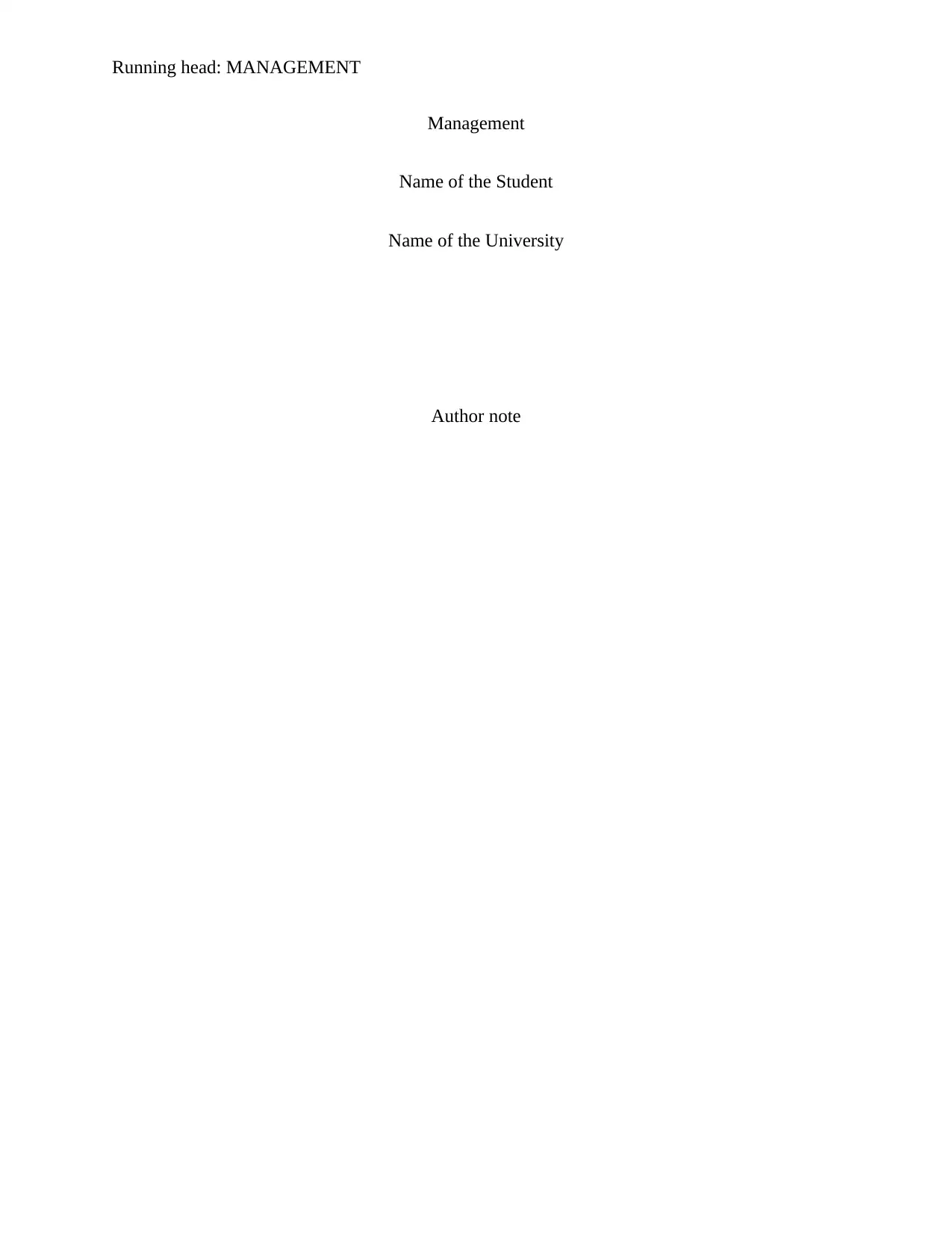
Running head: MANAGEMENT
Management
Name of the Student
Name of the University
Author note
Management
Name of the Student
Name of the University
Author note
Paraphrase This Document
Need a fresh take? Get an instant paraphrase of this document with our AI Paraphraser
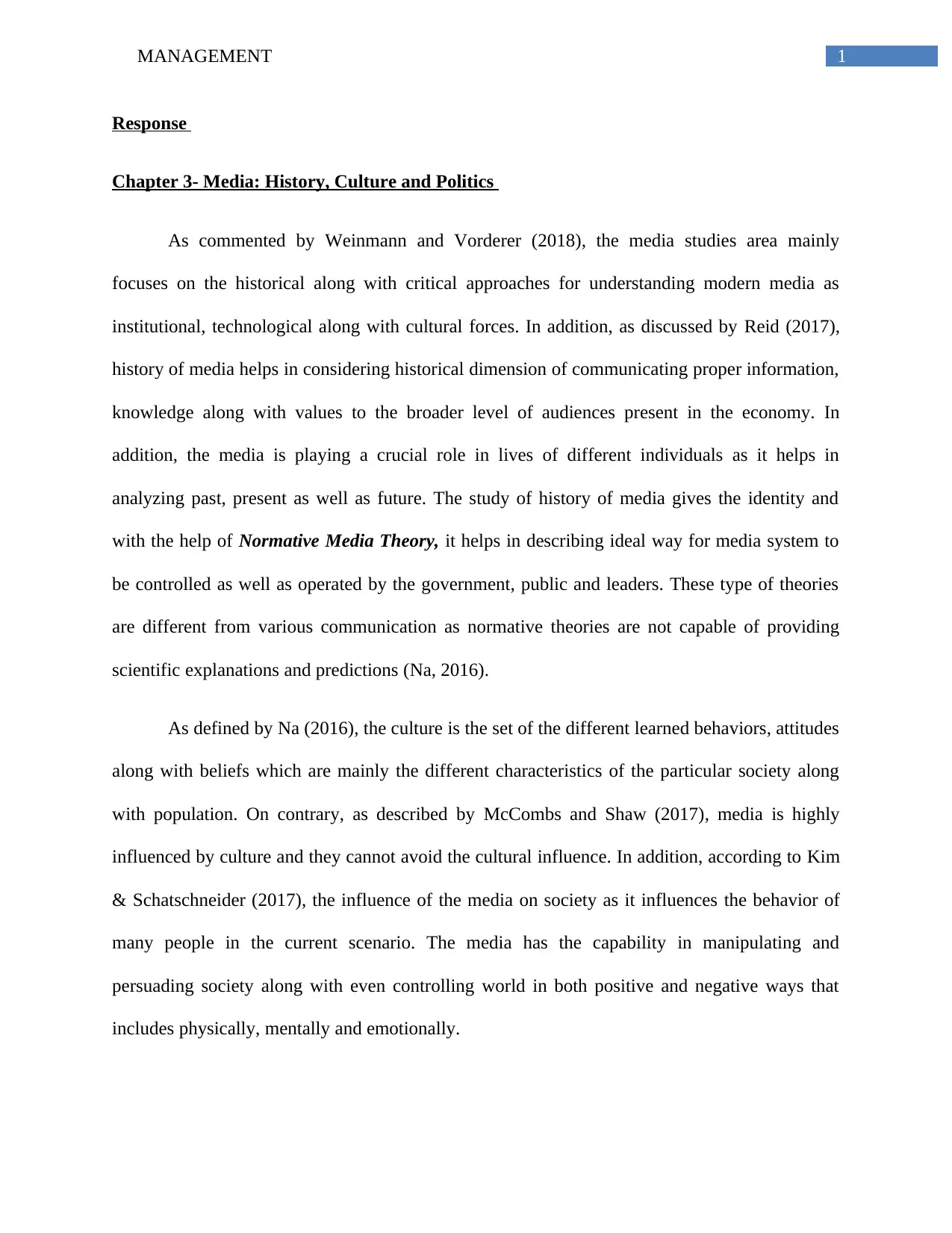
1MANAGEMENT
Response
Chapter 3- Media: History, Culture and Politics
As commented by Weinmann and Vorderer (2018), the media studies area mainly
focuses on the historical along with critical approaches for understanding modern media as
institutional, technological along with cultural forces. In addition, as discussed by Reid (2017),
history of media helps in considering historical dimension of communicating proper information,
knowledge along with values to the broader level of audiences present in the economy. In
addition, the media is playing a crucial role in lives of different individuals as it helps in
analyzing past, present as well as future. The study of history of media gives the identity and
with the help of Normative Media Theory, it helps in describing ideal way for media system to
be controlled as well as operated by the government, public and leaders. These type of theories
are different from various communication as normative theories are not capable of providing
scientific explanations and predictions (Na, 2016).
As defined by Na (2016), the culture is the set of the different learned behaviors, attitudes
along with beliefs which are mainly the different characteristics of the particular society along
with population. On contrary, as described by McCombs and Shaw (2017), media is highly
influenced by culture and they cannot avoid the cultural influence. In addition, according to Kim
& Schatschneider (2017), the influence of the media on society as it influences the behavior of
many people in the current scenario. The media has the capability in manipulating and
persuading society along with even controlling world in both positive and negative ways that
includes physically, mentally and emotionally.
Response
Chapter 3- Media: History, Culture and Politics
As commented by Weinmann and Vorderer (2018), the media studies area mainly
focuses on the historical along with critical approaches for understanding modern media as
institutional, technological along with cultural forces. In addition, as discussed by Reid (2017),
history of media helps in considering historical dimension of communicating proper information,
knowledge along with values to the broader level of audiences present in the economy. In
addition, the media is playing a crucial role in lives of different individuals as it helps in
analyzing past, present as well as future. The study of history of media gives the identity and
with the help of Normative Media Theory, it helps in describing ideal way for media system to
be controlled as well as operated by the government, public and leaders. These type of theories
are different from various communication as normative theories are not capable of providing
scientific explanations and predictions (Na, 2016).
As defined by Na (2016), the culture is the set of the different learned behaviors, attitudes
along with beliefs which are mainly the different characteristics of the particular society along
with population. On contrary, as described by McCombs and Shaw (2017), media is highly
influenced by culture and they cannot avoid the cultural influence. In addition, according to Kim
& Schatschneider (2017), the influence of the media on society as it influences the behavior of
many people in the current scenario. The media has the capability in manipulating and
persuading society along with even controlling world in both positive and negative ways that
includes physically, mentally and emotionally.
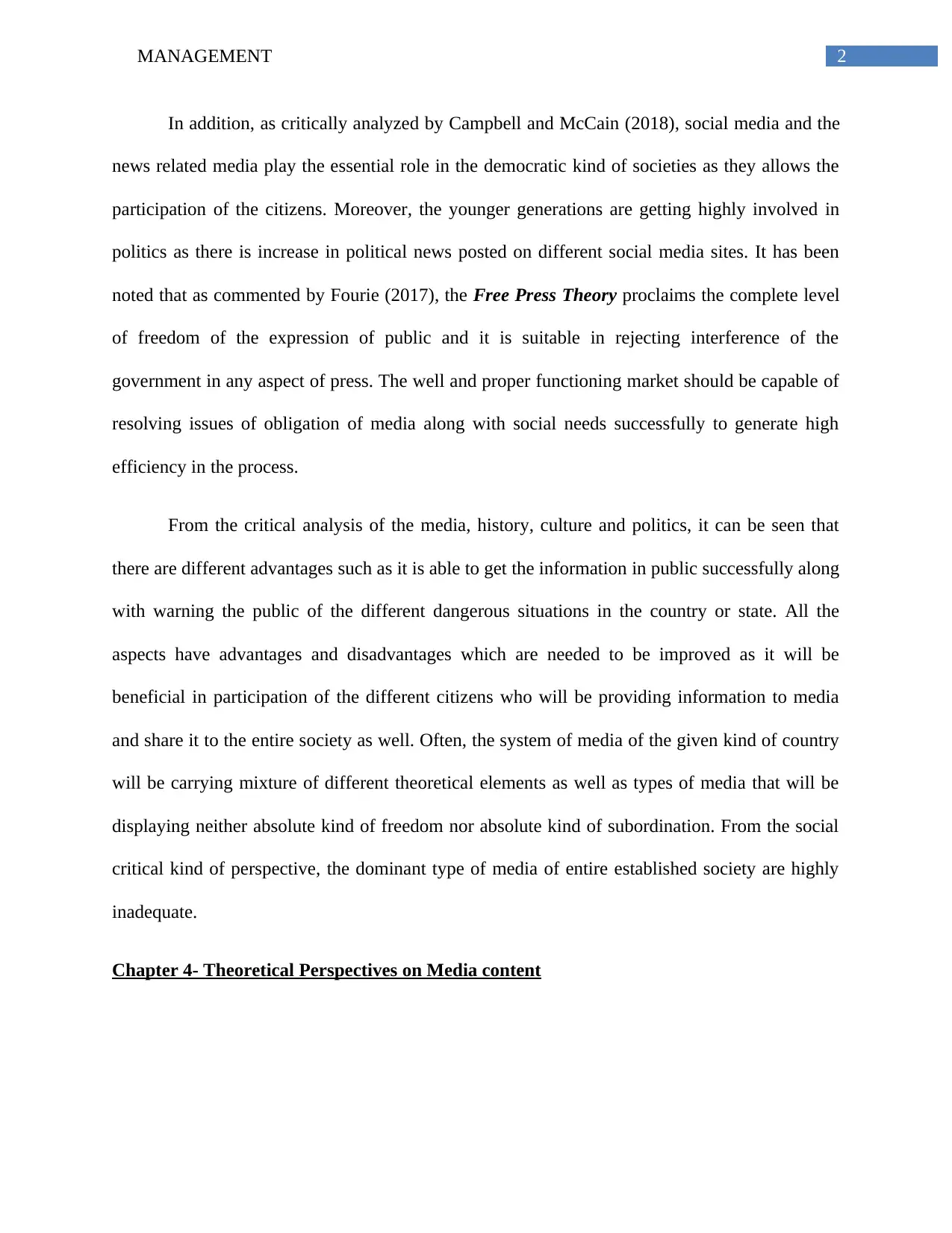
2MANAGEMENT
In addition, as critically analyzed by Campbell and McCain (2018), social media and the
news related media play the essential role in the democratic kind of societies as they allows the
participation of the citizens. Moreover, the younger generations are getting highly involved in
politics as there is increase in political news posted on different social media sites. It has been
noted that as commented by Fourie (2017), the Free Press Theory proclaims the complete level
of freedom of the expression of public and it is suitable in rejecting interference of the
government in any aspect of press. The well and proper functioning market should be capable of
resolving issues of obligation of media along with social needs successfully to generate high
efficiency in the process.
From the critical analysis of the media, history, culture and politics, it can be seen that
there are different advantages such as it is able to get the information in public successfully along
with warning the public of the different dangerous situations in the country or state. All the
aspects have advantages and disadvantages which are needed to be improved as it will be
beneficial in participation of the different citizens who will be providing information to media
and share it to the entire society as well. Often, the system of media of the given kind of country
will be carrying mixture of different theoretical elements as well as types of media that will be
displaying neither absolute kind of freedom nor absolute kind of subordination. From the social
critical kind of perspective, the dominant type of media of entire established society are highly
inadequate.
Chapter 4- Theoretical Perspectives on Media content
In addition, as critically analyzed by Campbell and McCain (2018), social media and the
news related media play the essential role in the democratic kind of societies as they allows the
participation of the citizens. Moreover, the younger generations are getting highly involved in
politics as there is increase in political news posted on different social media sites. It has been
noted that as commented by Fourie (2017), the Free Press Theory proclaims the complete level
of freedom of the expression of public and it is suitable in rejecting interference of the
government in any aspect of press. The well and proper functioning market should be capable of
resolving issues of obligation of media along with social needs successfully to generate high
efficiency in the process.
From the critical analysis of the media, history, culture and politics, it can be seen that
there are different advantages such as it is able to get the information in public successfully along
with warning the public of the different dangerous situations in the country or state. All the
aspects have advantages and disadvantages which are needed to be improved as it will be
beneficial in participation of the different citizens who will be providing information to media
and share it to the entire society as well. Often, the system of media of the given kind of country
will be carrying mixture of different theoretical elements as well as types of media that will be
displaying neither absolute kind of freedom nor absolute kind of subordination. From the social
critical kind of perspective, the dominant type of media of entire established society are highly
inadequate.
Chapter 4- Theoretical Perspectives on Media content
⊘ This is a preview!⊘
Do you want full access?
Subscribe today to unlock all pages.

Trusted by 1+ million students worldwide
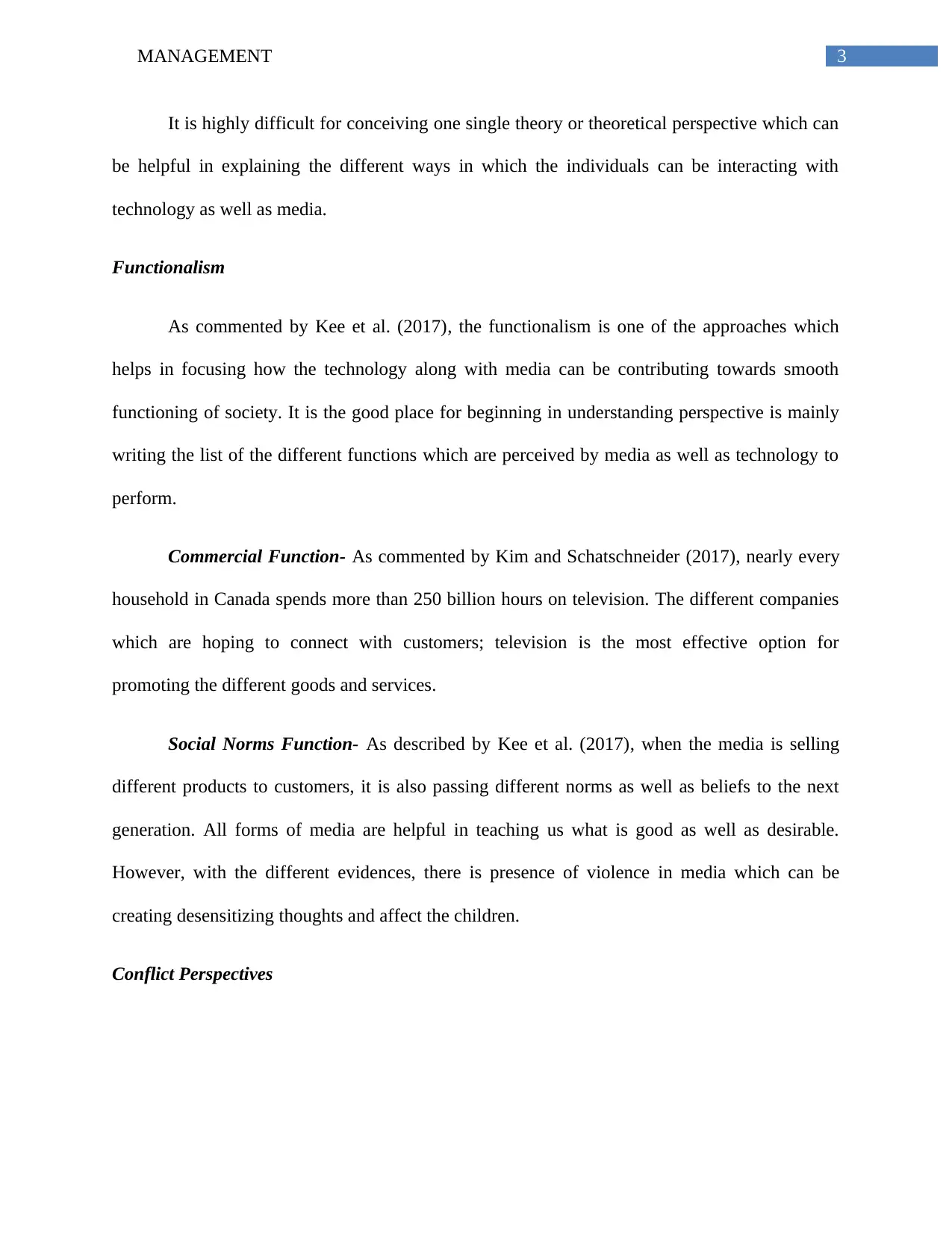
3MANAGEMENT
It is highly difficult for conceiving one single theory or theoretical perspective which can
be helpful in explaining the different ways in which the individuals can be interacting with
technology as well as media.
Functionalism
As commented by Kee et al. (2017), the functionalism is one of the approaches which
helps in focusing how the technology along with media can be contributing towards smooth
functioning of society. It is the good place for beginning in understanding perspective is mainly
writing the list of the different functions which are perceived by media as well as technology to
perform.
Commercial Function- As commented by Kim and Schatschneider (2017), nearly every
household in Canada spends more than 250 billion hours on television. The different companies
which are hoping to connect with customers; television is the most effective option for
promoting the different goods and services.
Social Norms Function- As described by Kee et al. (2017), when the media is selling
different products to customers, it is also passing different norms as well as beliefs to the next
generation. All forms of media are helpful in teaching us what is good as well as desirable.
However, with the different evidences, there is presence of violence in media which can be
creating desensitizing thoughts and affect the children.
Conflict Perspectives
It is highly difficult for conceiving one single theory or theoretical perspective which can
be helpful in explaining the different ways in which the individuals can be interacting with
technology as well as media.
Functionalism
As commented by Kee et al. (2017), the functionalism is one of the approaches which
helps in focusing how the technology along with media can be contributing towards smooth
functioning of society. It is the good place for beginning in understanding perspective is mainly
writing the list of the different functions which are perceived by media as well as technology to
perform.
Commercial Function- As commented by Kim and Schatschneider (2017), nearly every
household in Canada spends more than 250 billion hours on television. The different companies
which are hoping to connect with customers; television is the most effective option for
promoting the different goods and services.
Social Norms Function- As described by Kee et al. (2017), when the media is selling
different products to customers, it is also passing different norms as well as beliefs to the next
generation. All forms of media are helpful in teaching us what is good as well as desirable.
However, with the different evidences, there is presence of violence in media which can be
creating desensitizing thoughts and affect the children.
Conflict Perspectives
Paraphrase This Document
Need a fresh take? Get an instant paraphrase of this document with our AI Paraphraser
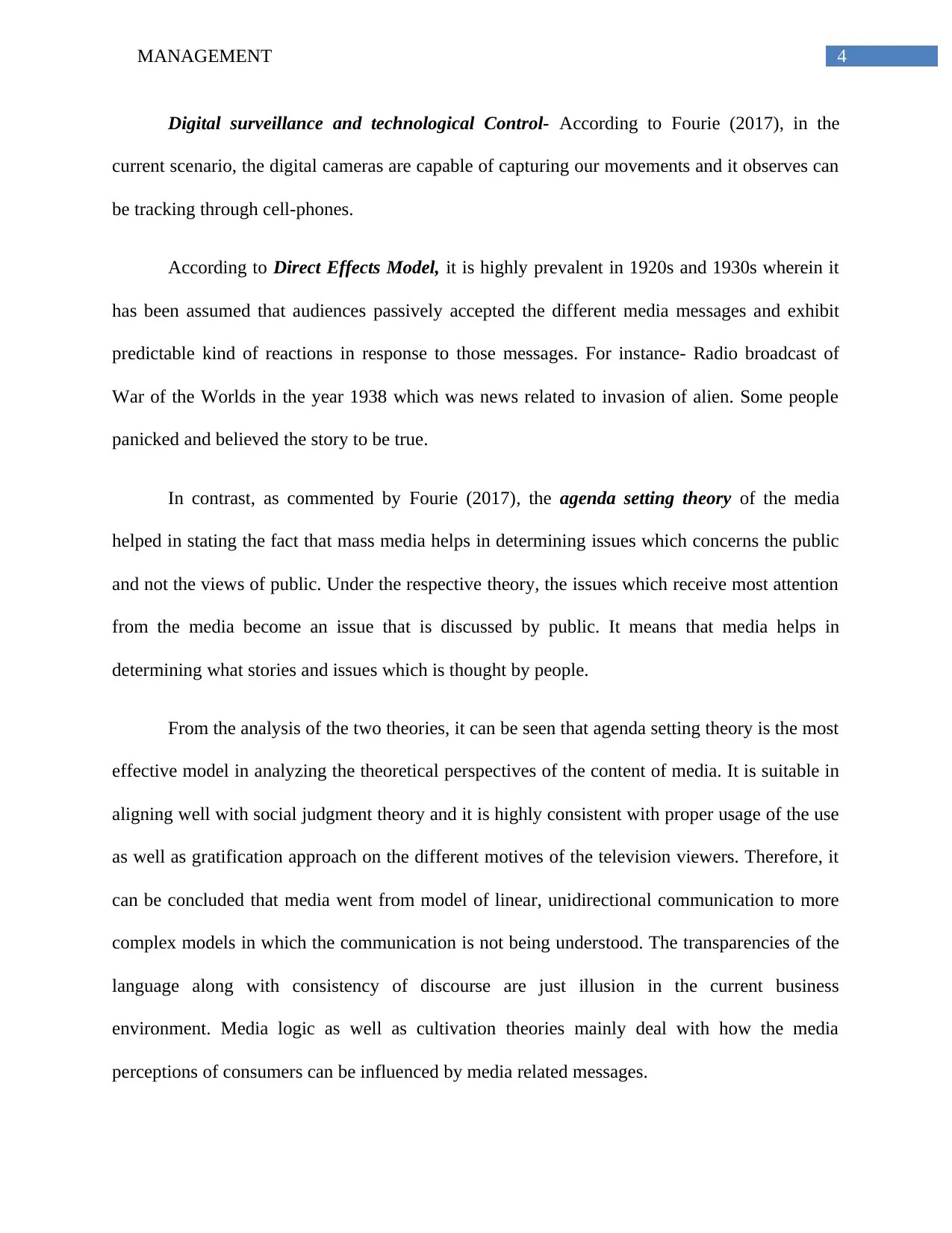
4MANAGEMENT
Digital surveillance and technological Control- According to Fourie (2017), in the
current scenario, the digital cameras are capable of capturing our movements and it observes can
be tracking through cell-phones.
According to Direct Effects Model, it is highly prevalent in 1920s and 1930s wherein it
has been assumed that audiences passively accepted the different media messages and exhibit
predictable kind of reactions in response to those messages. For instance- Radio broadcast of
War of the Worlds in the year 1938 which was news related to invasion of alien. Some people
panicked and believed the story to be true.
In contrast, as commented by Fourie (2017), the agenda setting theory of the media
helped in stating the fact that mass media helps in determining issues which concerns the public
and not the views of public. Under the respective theory, the issues which receive most attention
from the media become an issue that is discussed by public. It means that media helps in
determining what stories and issues which is thought by people.
From the analysis of the two theories, it can be seen that agenda setting theory is the most
effective model in analyzing the theoretical perspectives of the content of media. It is suitable in
aligning well with social judgment theory and it is highly consistent with proper usage of the use
as well as gratification approach on the different motives of the television viewers. Therefore, it
can be concluded that media went from model of linear, unidirectional communication to more
complex models in which the communication is not being understood. The transparencies of the
language along with consistency of discourse are just illusion in the current business
environment. Media logic as well as cultivation theories mainly deal with how the media
perceptions of consumers can be influenced by media related messages.
Digital surveillance and technological Control- According to Fourie (2017), in the
current scenario, the digital cameras are capable of capturing our movements and it observes can
be tracking through cell-phones.
According to Direct Effects Model, it is highly prevalent in 1920s and 1930s wherein it
has been assumed that audiences passively accepted the different media messages and exhibit
predictable kind of reactions in response to those messages. For instance- Radio broadcast of
War of the Worlds in the year 1938 which was news related to invasion of alien. Some people
panicked and believed the story to be true.
In contrast, as commented by Fourie (2017), the agenda setting theory of the media
helped in stating the fact that mass media helps in determining issues which concerns the public
and not the views of public. Under the respective theory, the issues which receive most attention
from the media become an issue that is discussed by public. It means that media helps in
determining what stories and issues which is thought by people.
From the analysis of the two theories, it can be seen that agenda setting theory is the most
effective model in analyzing the theoretical perspectives of the content of media. It is suitable in
aligning well with social judgment theory and it is highly consistent with proper usage of the use
as well as gratification approach on the different motives of the television viewers. Therefore, it
can be concluded that media went from model of linear, unidirectional communication to more
complex models in which the communication is not being understood. The transparencies of the
language along with consistency of discourse are just illusion in the current business
environment. Media logic as well as cultivation theories mainly deal with how the media
perceptions of consumers can be influenced by media related messages.
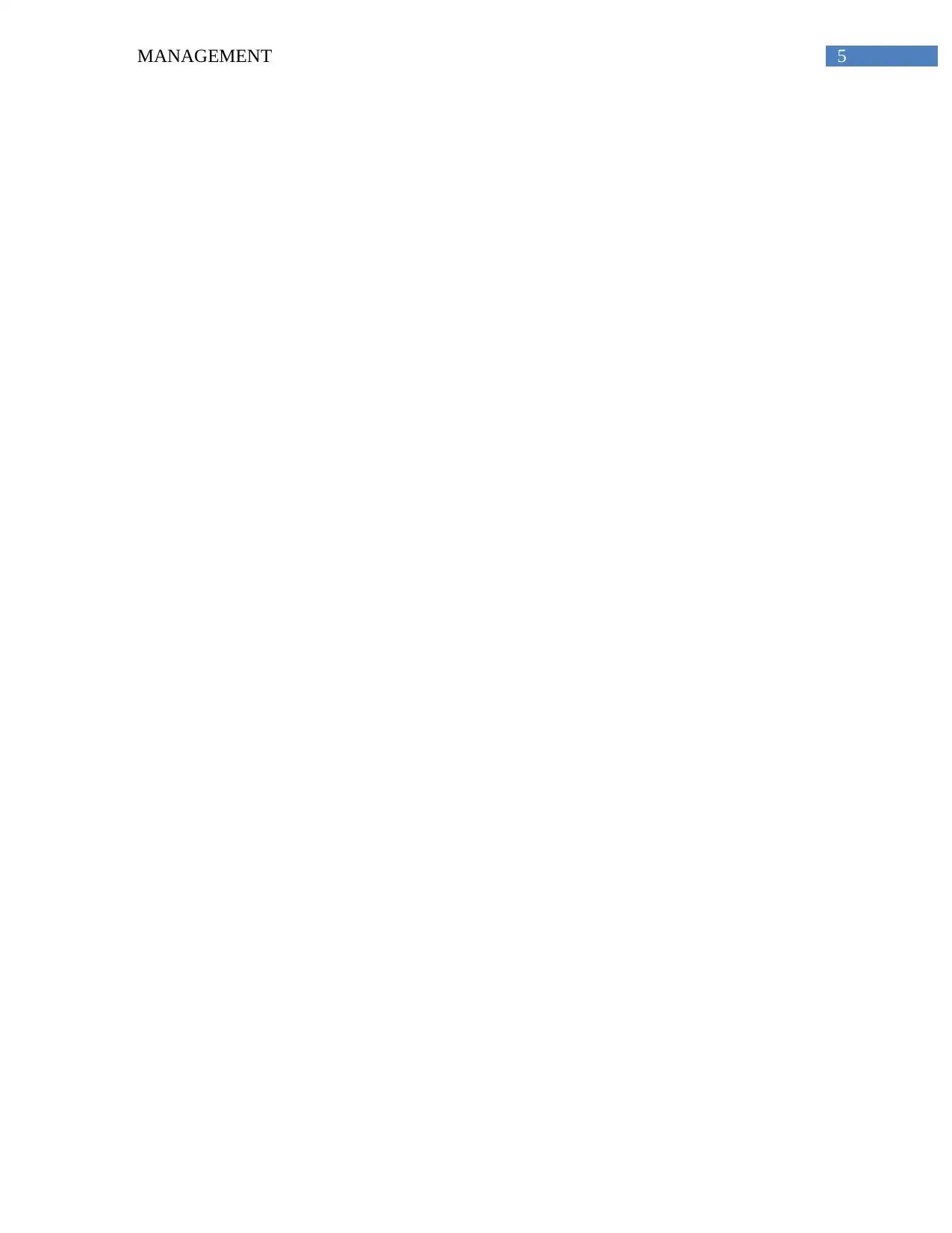
5MANAGEMENT
⊘ This is a preview!⊘
Do you want full access?
Subscribe today to unlock all pages.

Trusted by 1+ million students worldwide
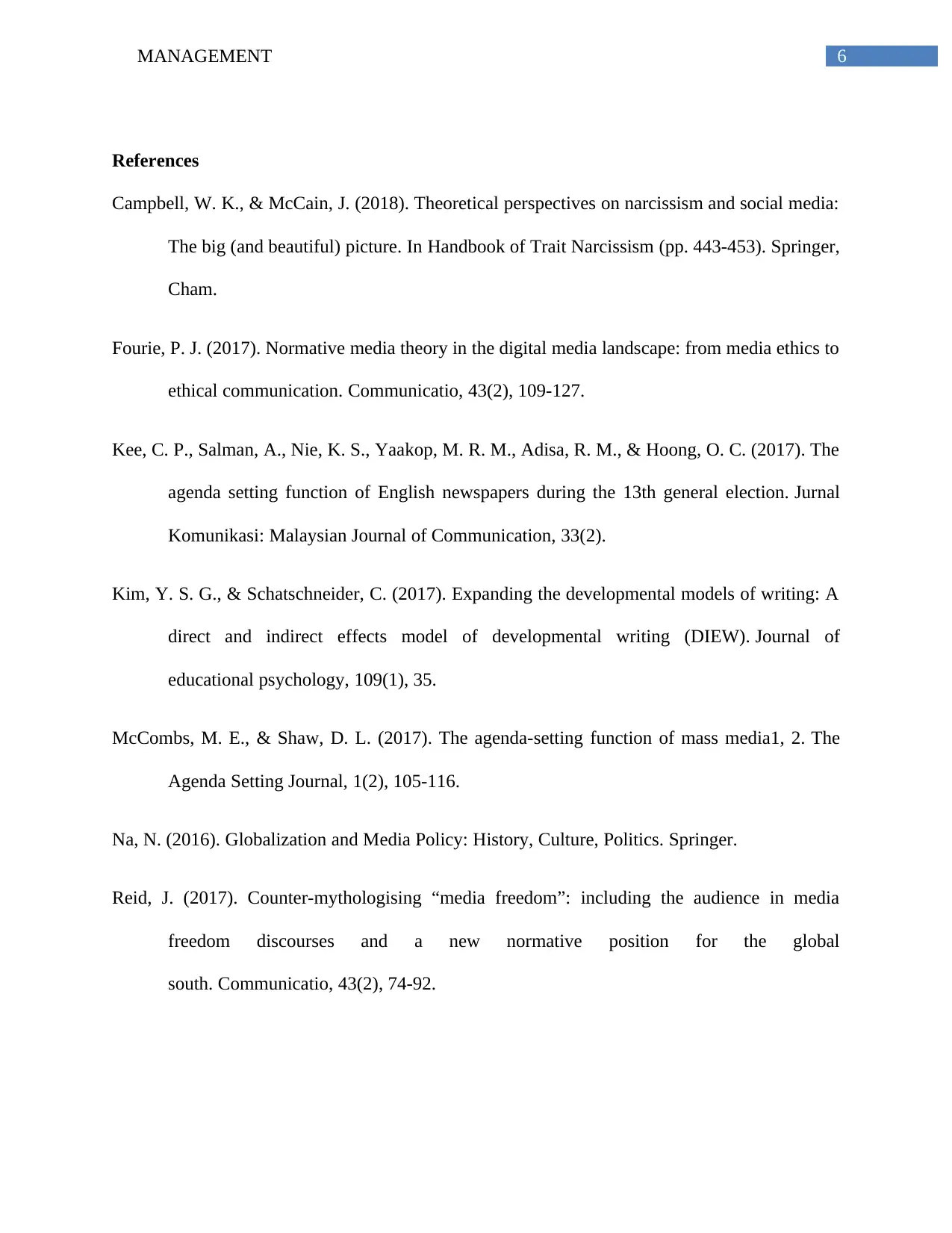
6MANAGEMENT
References
Campbell, W. K., & McCain, J. (2018). Theoretical perspectives on narcissism and social media:
The big (and beautiful) picture. In Handbook of Trait Narcissism (pp. 443-453). Springer,
Cham.
Fourie, P. J. (2017). Normative media theory in the digital media landscape: from media ethics to
ethical communication. Communicatio, 43(2), 109-127.
Kee, C. P., Salman, A., Nie, K. S., Yaakop, M. R. M., Adisa, R. M., & Hoong, O. C. (2017). The
agenda setting function of English newspapers during the 13th general election. Jurnal
Komunikasi: Malaysian Journal of Communication, 33(2).
Kim, Y. S. G., & Schatschneider, C. (2017). Expanding the developmental models of writing: A
direct and indirect effects model of developmental writing (DIEW). Journal of
educational psychology, 109(1), 35.
McCombs, M. E., & Shaw, D. L. (2017). The agenda-setting function of mass media1, 2. The
Agenda Setting Journal, 1(2), 105-116.
Na, N. (2016). Globalization and Media Policy: History, Culture, Politics. Springer.
Reid, J. (2017). Counter-mythologising “media freedom”: including the audience in media
freedom discourses and a new normative position for the global
south. Communicatio, 43(2), 74-92.
References
Campbell, W. K., & McCain, J. (2018). Theoretical perspectives on narcissism and social media:
The big (and beautiful) picture. In Handbook of Trait Narcissism (pp. 443-453). Springer,
Cham.
Fourie, P. J. (2017). Normative media theory in the digital media landscape: from media ethics to
ethical communication. Communicatio, 43(2), 109-127.
Kee, C. P., Salman, A., Nie, K. S., Yaakop, M. R. M., Adisa, R. M., & Hoong, O. C. (2017). The
agenda setting function of English newspapers during the 13th general election. Jurnal
Komunikasi: Malaysian Journal of Communication, 33(2).
Kim, Y. S. G., & Schatschneider, C. (2017). Expanding the developmental models of writing: A
direct and indirect effects model of developmental writing (DIEW). Journal of
educational psychology, 109(1), 35.
McCombs, M. E., & Shaw, D. L. (2017). The agenda-setting function of mass media1, 2. The
Agenda Setting Journal, 1(2), 105-116.
Na, N. (2016). Globalization and Media Policy: History, Culture, Politics. Springer.
Reid, J. (2017). Counter-mythologising “media freedom”: including the audience in media
freedom discourses and a new normative position for the global
south. Communicatio, 43(2), 74-92.
Paraphrase This Document
Need a fresh take? Get an instant paraphrase of this document with our AI Paraphraser
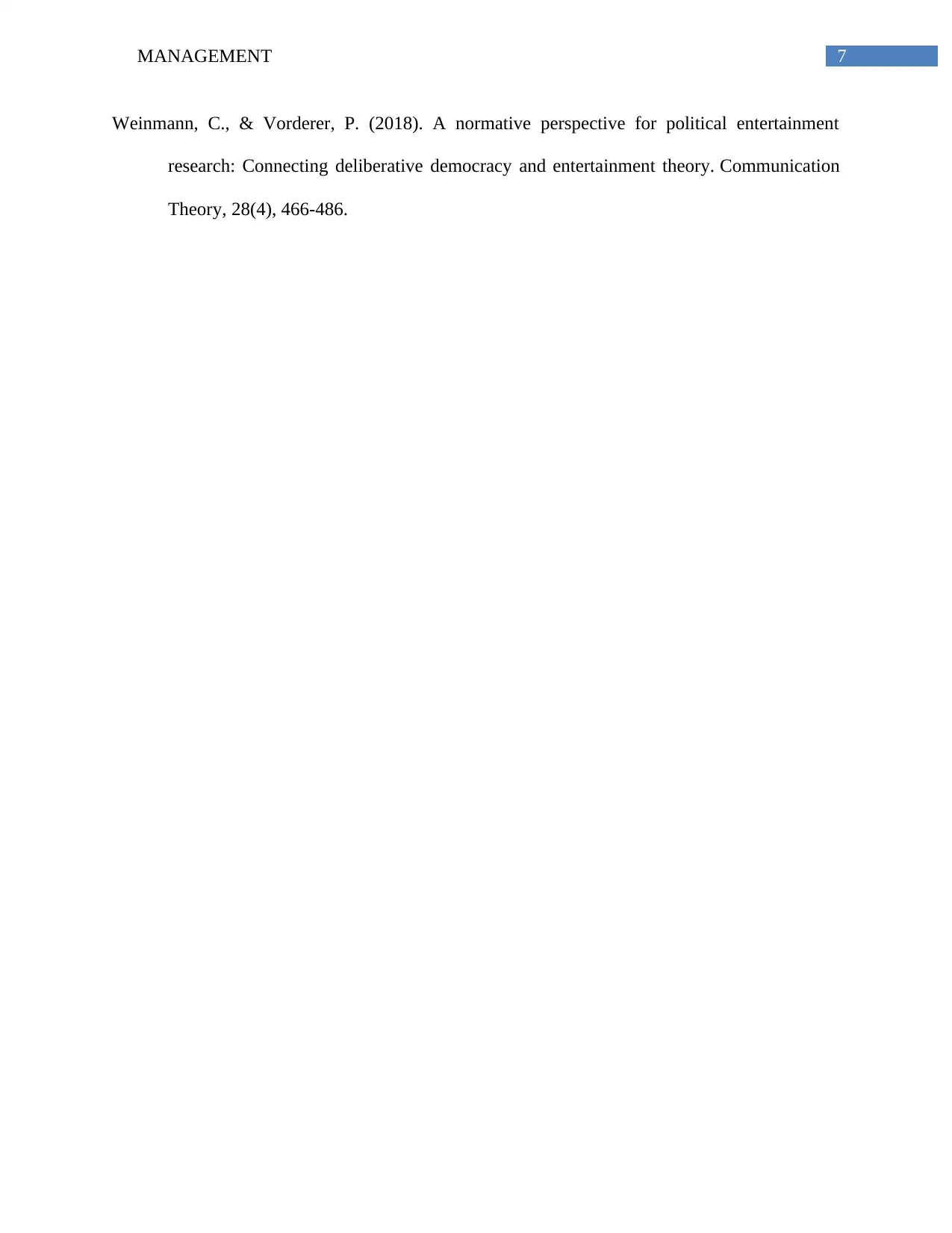
7MANAGEMENT
Weinmann, C., & Vorderer, P. (2018). A normative perspective for political entertainment
research: Connecting deliberative democracy and entertainment theory. Communication
Theory, 28(4), 466-486.
Weinmann, C., & Vorderer, P. (2018). A normative perspective for political entertainment
research: Connecting deliberative democracy and entertainment theory. Communication
Theory, 28(4), 466-486.
1 out of 8
Related Documents
Your All-in-One AI-Powered Toolkit for Academic Success.
+13062052269
info@desklib.com
Available 24*7 on WhatsApp / Email
![[object Object]](/_next/static/media/star-bottom.7253800d.svg)
Unlock your academic potential
Copyright © 2020–2025 A2Z Services. All Rights Reserved. Developed and managed by ZUCOL.





